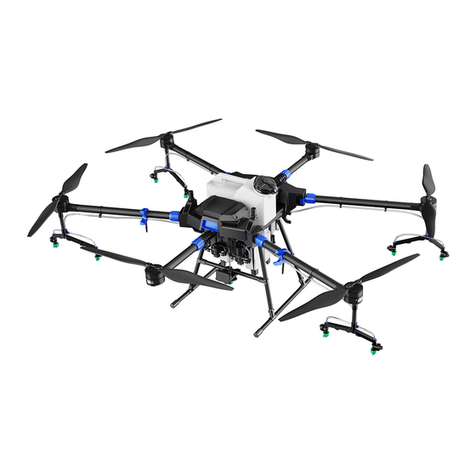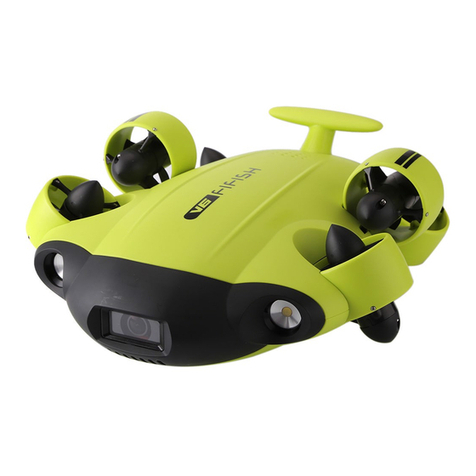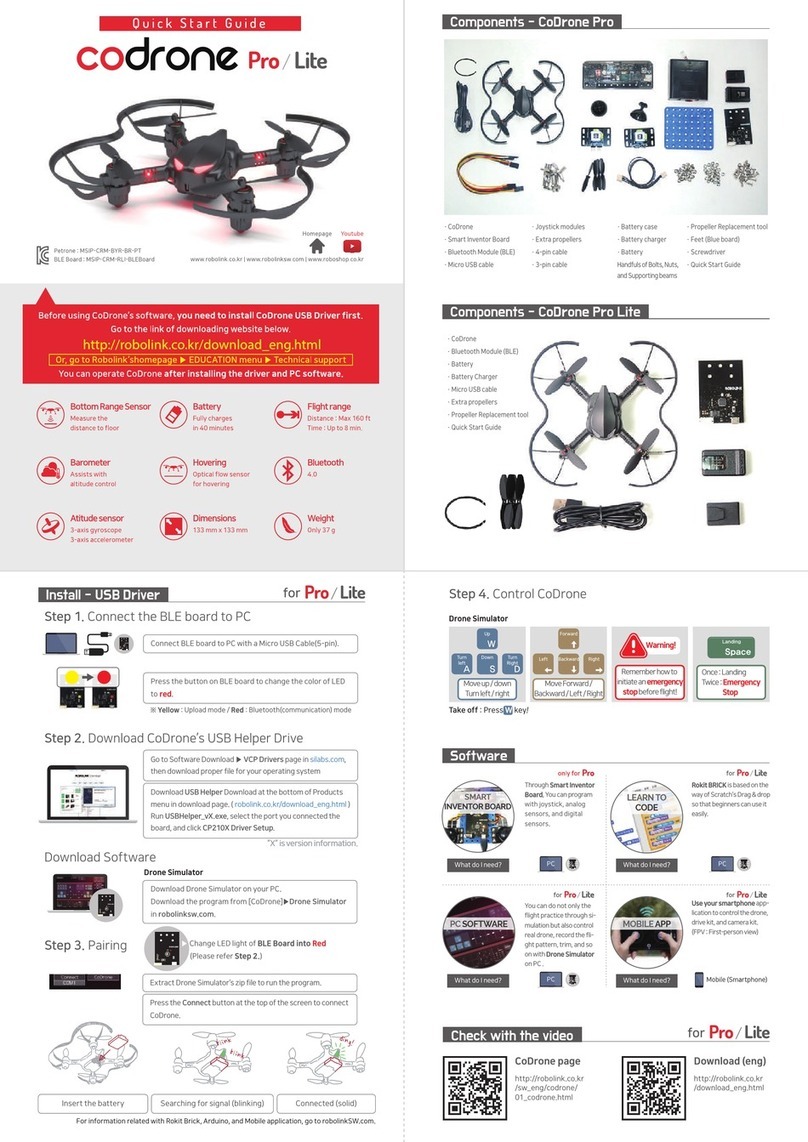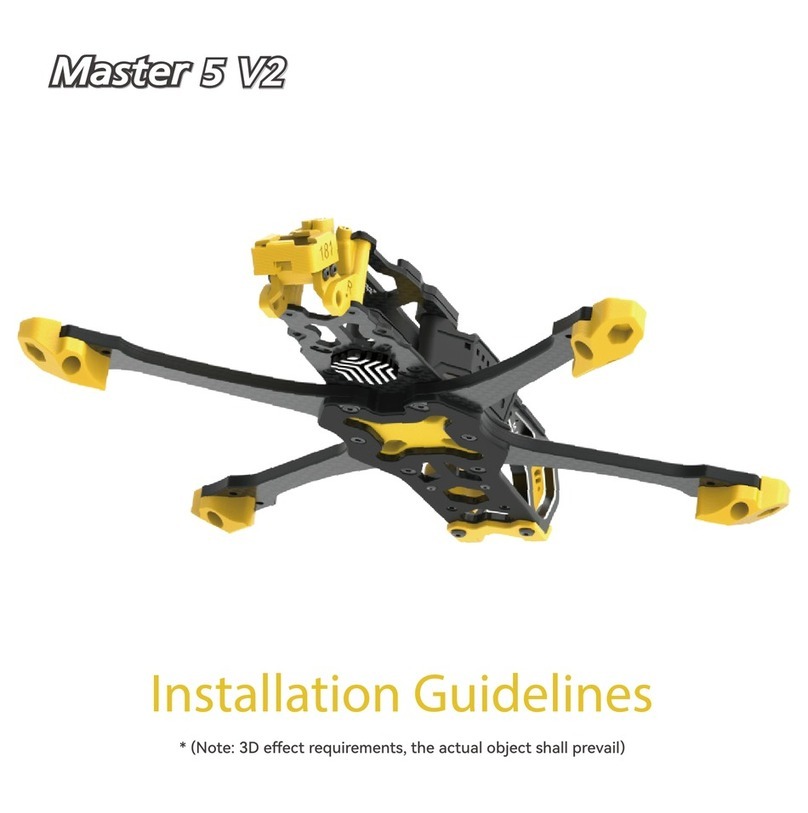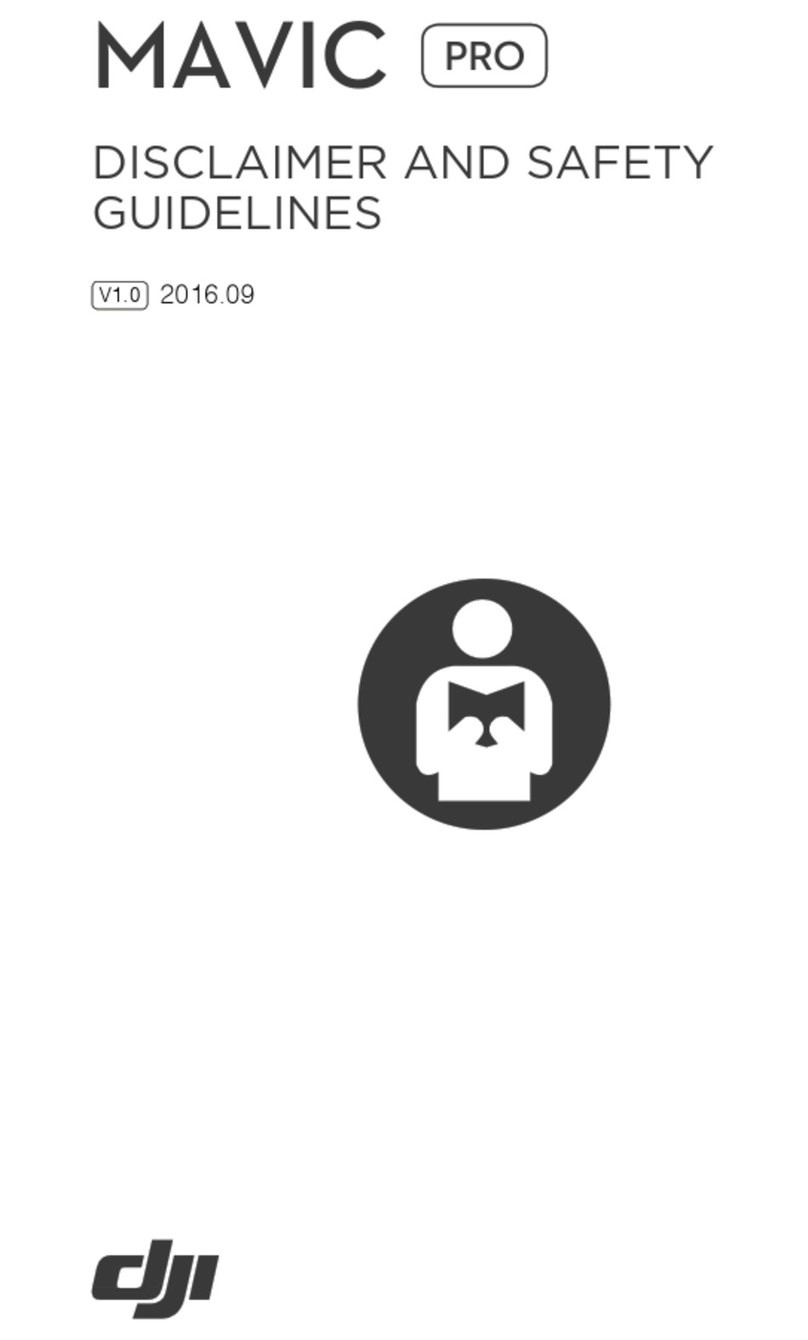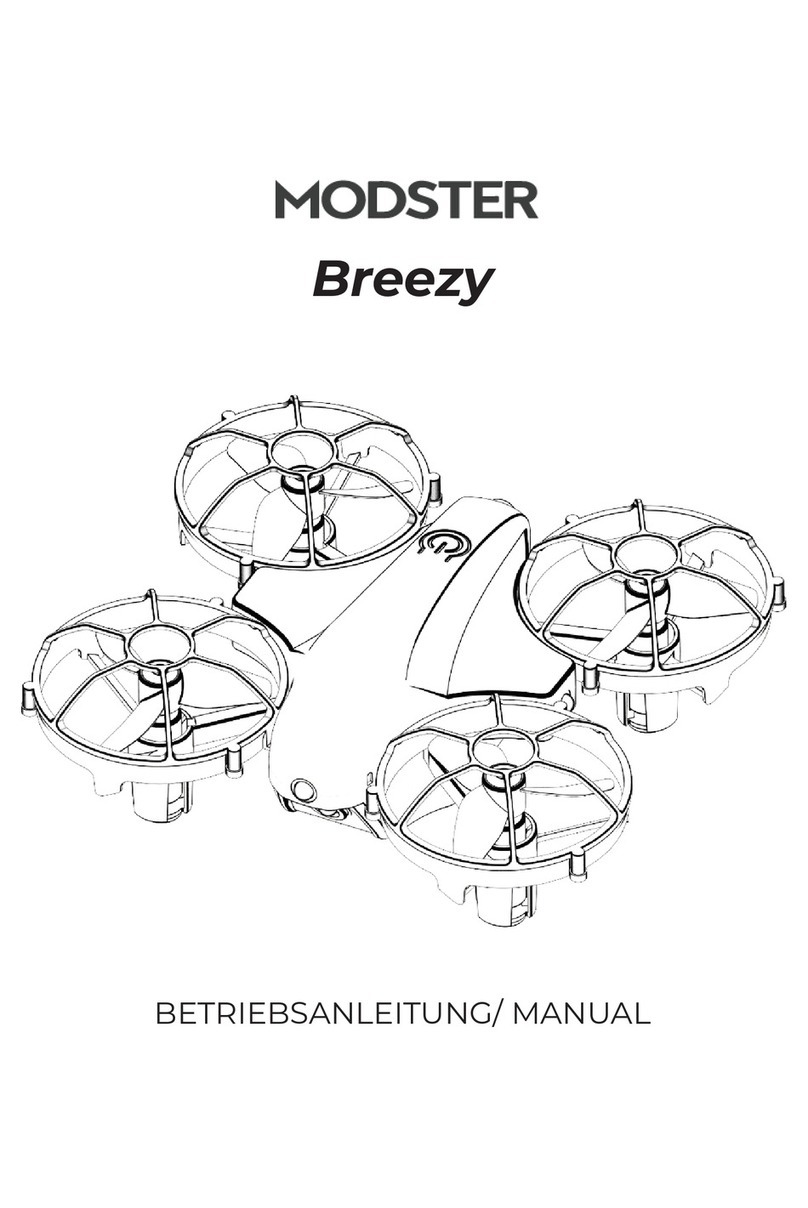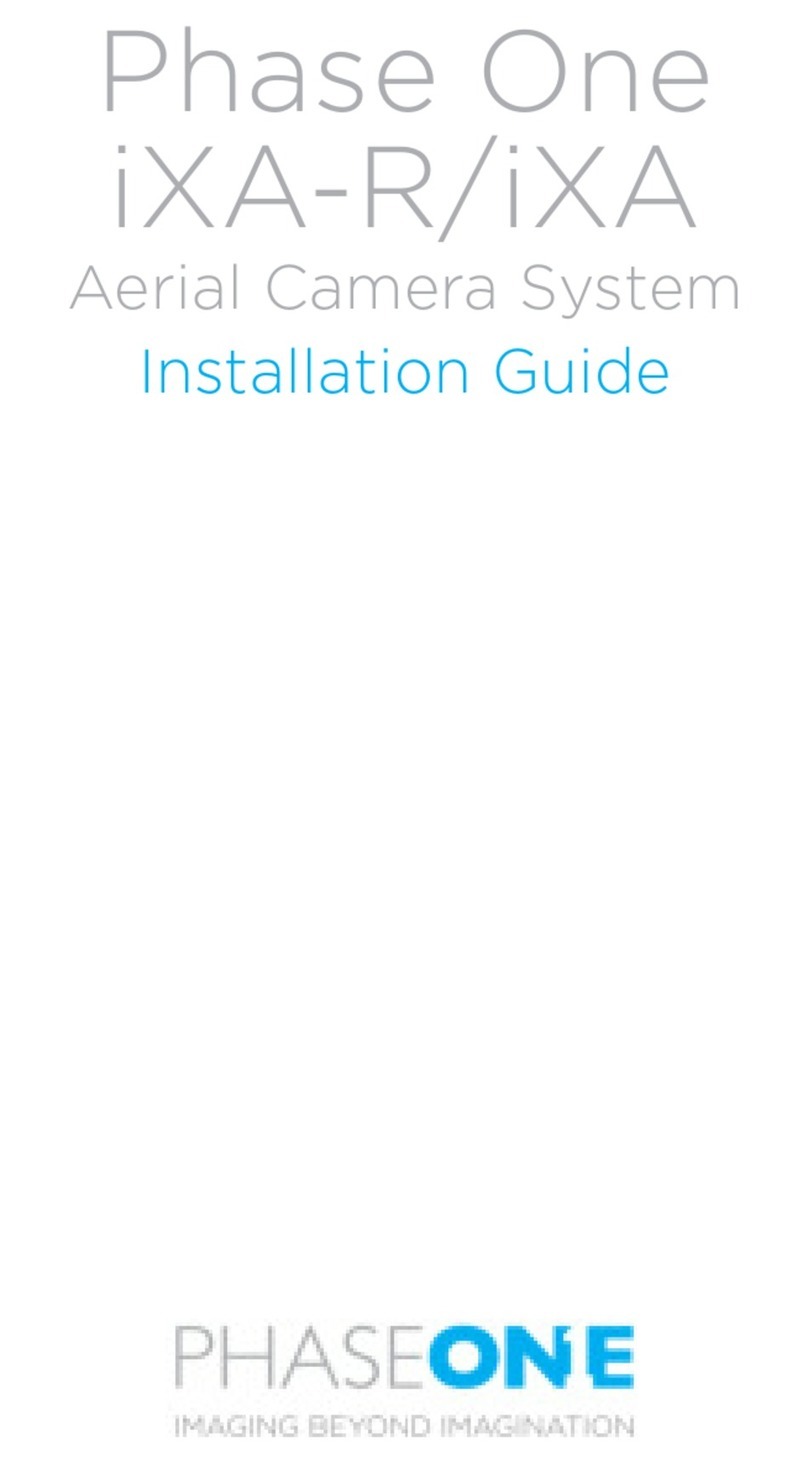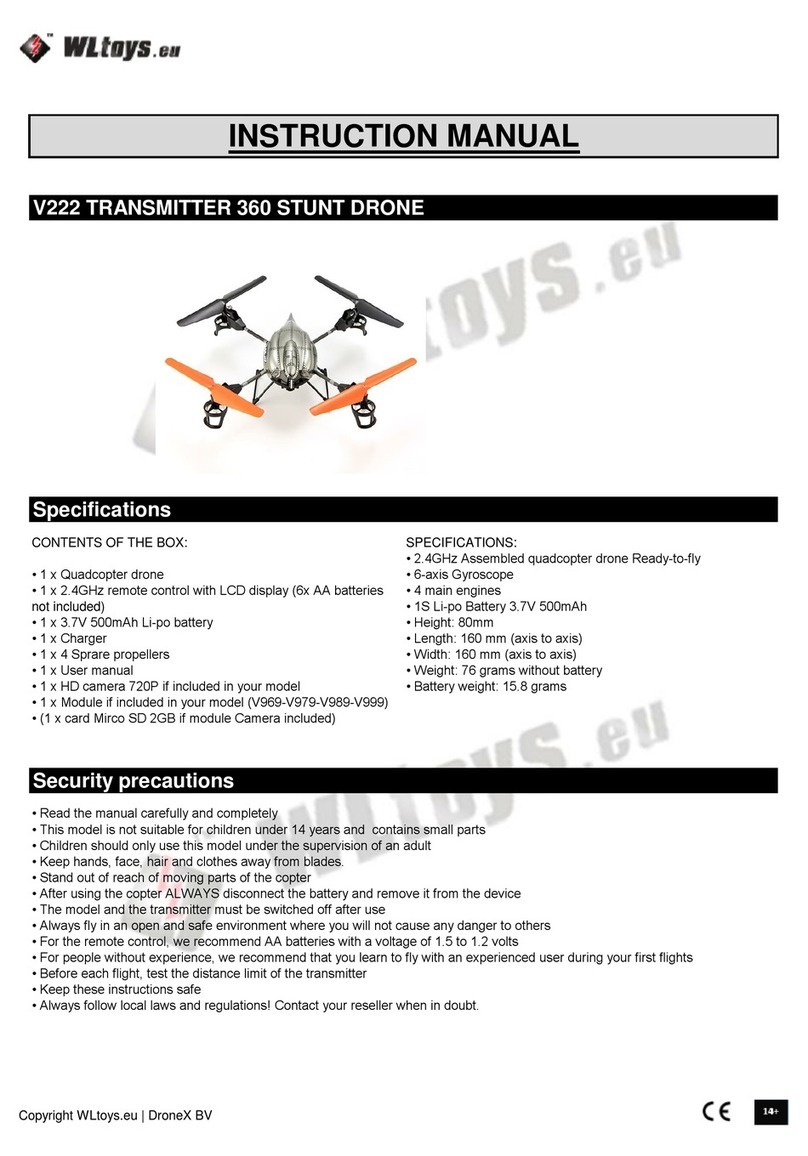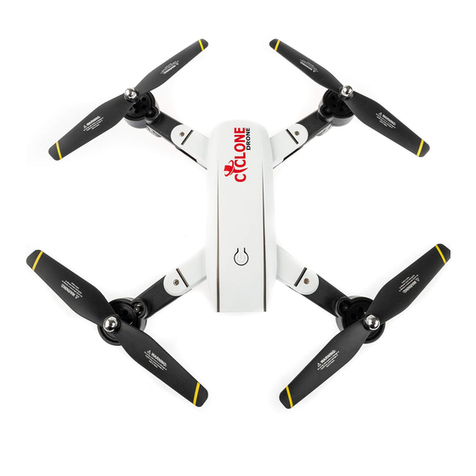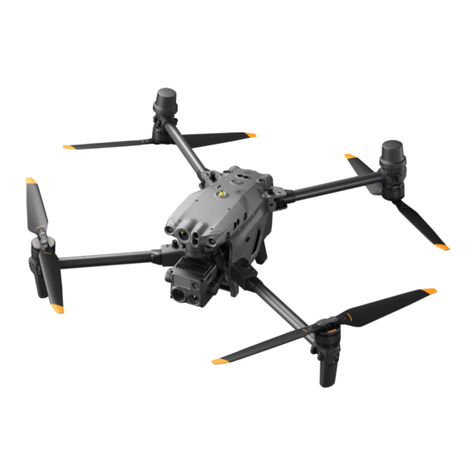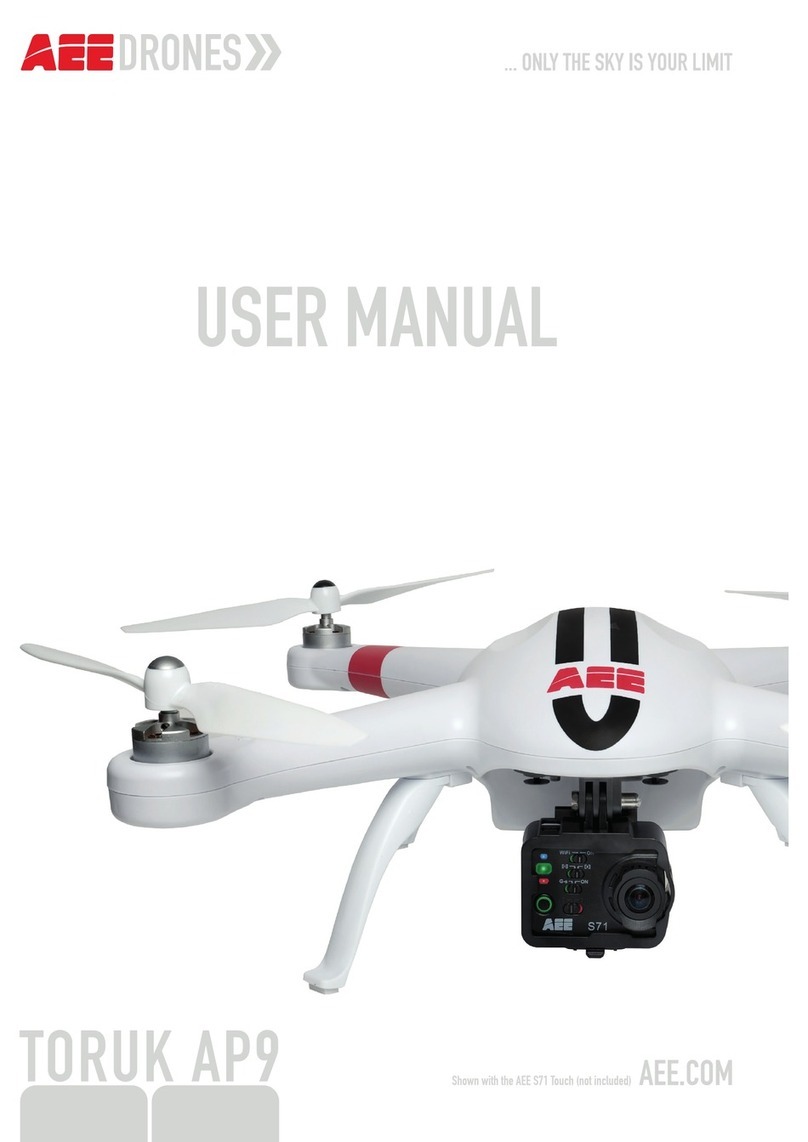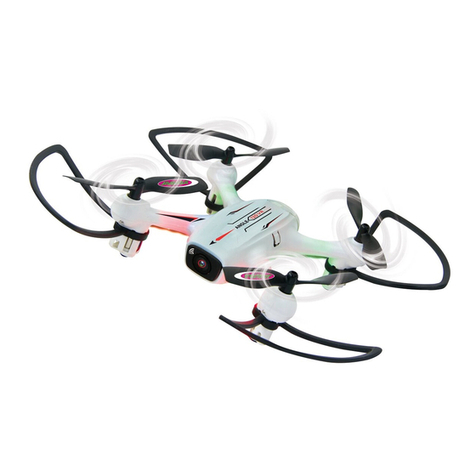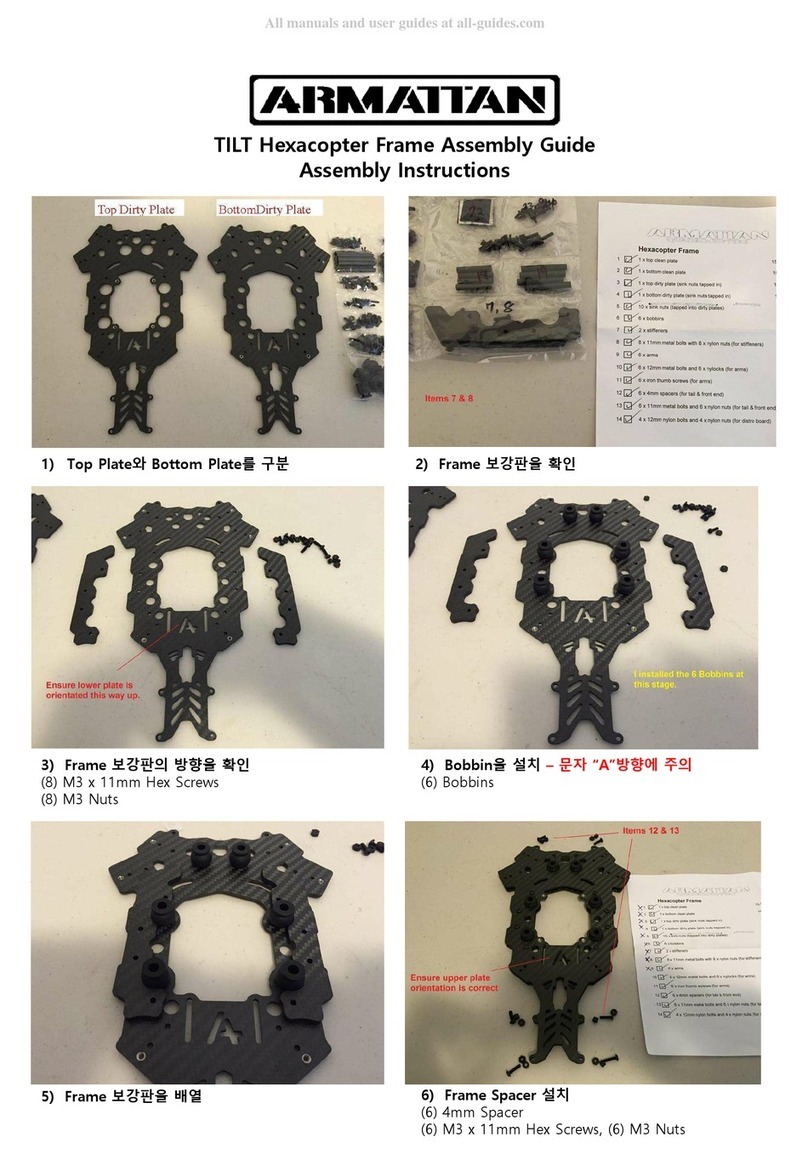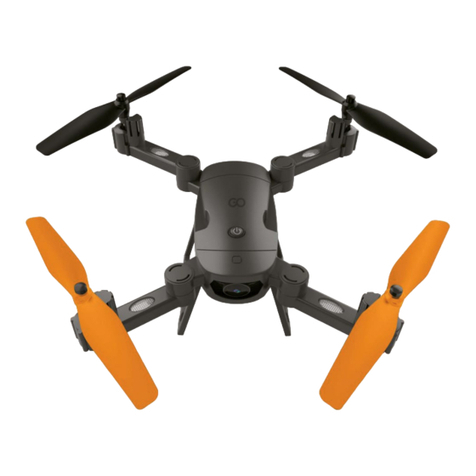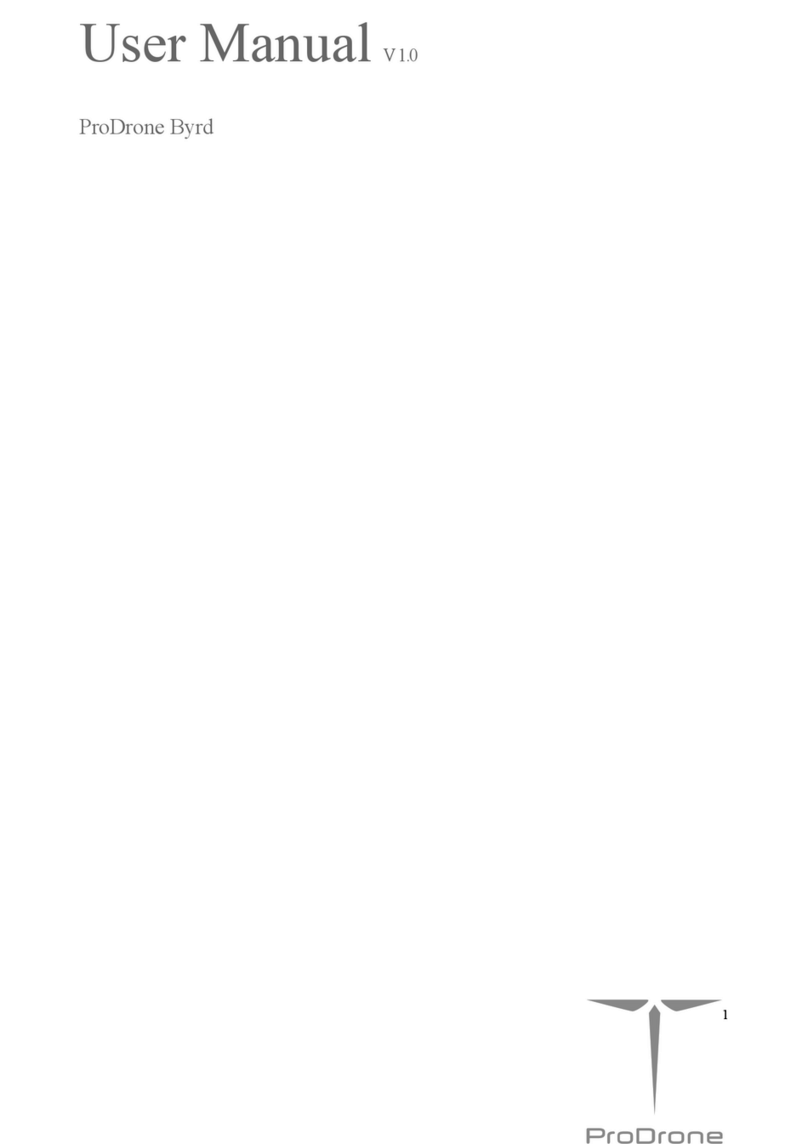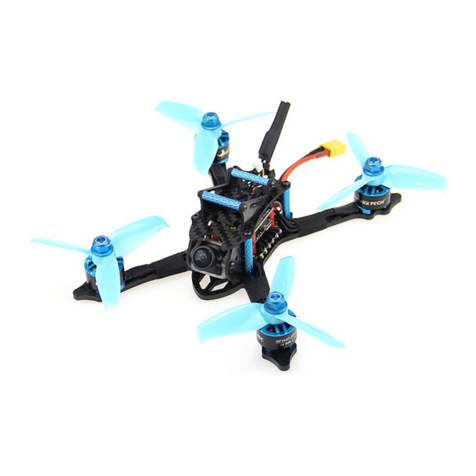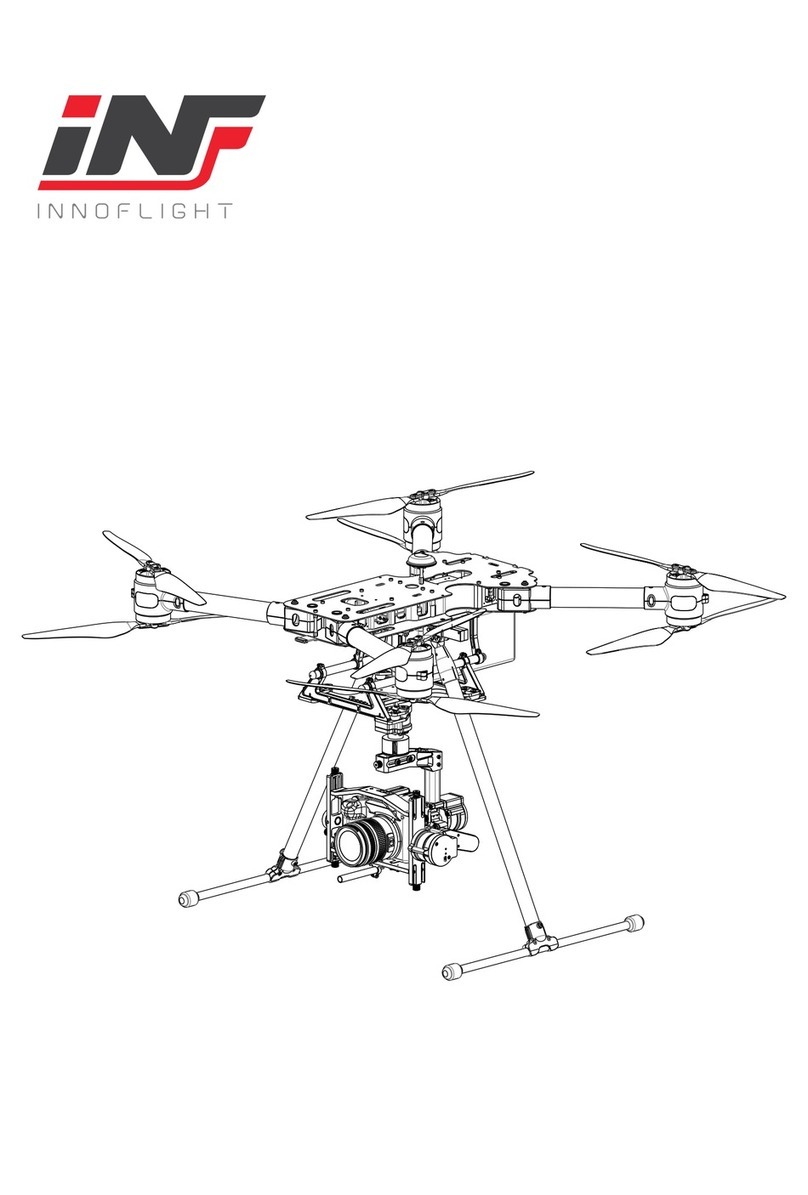TopXGun 3WWDZ-30.1 User manual

3WWDZ-30.1
Agriculture drone
User Manual V1.2
Topxgun (Nanjing) Robotics Co., Ltd.
2022.2
Usage Recommendation
Topxgun provides user with the following documents:
1. “Packing List”
2. “User Manual of Plant Protection UAV FP300”
3. “Usage Guidelines of Agriculture Assistant APP”
For detailed usage and functions, please refer to “User Manual of Plant
Protection UAV FP300" and "Usage Guidelines of Agriculture Assistant APP”.
You can also follow us on YouTube Channel for tutorials and tips in the
operation.
* To keep you updated, some documents may be taken as E-documents.

User Manual of Plant
Protection UAV 3WWDZ-30.1
Usage Guidelines of
Agriculture Assistant APP
Agriculture Assistant APP

©2022 Topxgun (Nanjing) Robotics Co., Ltd. Copyright owner 1
Preface
The plant protection UAV 3WWDZ-30.1 is a mature multi-rotor aircraft, leading
the industry in terms of function, appearance, control, safety and other aspects.
There are certain usage risks of multi-rotor drones due to the mechanism and
structure. Please strictly follow the safety tips and user manual during the
operation. Violation of regulations when using this drone may result in direct or
indirect loss and damage.
Disclaimer
Please read the manual carefully before using the aircraft. Once the drone is
used, it is deemed to be an acknowledgement and acceptance of all the
content of this user manual. This drone is suitable for people 18 years of age
and older. Topxgun is not responsible for the loss of personal or property due
to the following problems:
1. The user does not assemble or use the drone as required by this manual.
2. The user operates the drone in poor physical or mental conditions such as
drinking, drug abuse, fatigue, etc.
3. The user actively or intentionally operates the drone to create damage.
4. The user modifies the drone without using the accessories from Topxgun,
which causes malfunction of the drone.
5. Injury caused by the user's misoperation or subjective misjudgment.
6. Damage caused by natural causes, such as aging of the circuit and so on
that affects the aircraft.
7. Damage caused by the user’s operation of the drone while knowing that it is
in an abnormal working condition.
8. The user still operates the drone under severe weather conditions such as
typhoons, hail and fog.
9. The user operates the drone in the magnetic interference area, radio
interference area and government no-fly area.
10. The user operates the drone in case of poor visibility and occlusion of the
line of sight.
11. The user operates the drone to cause the infringements by obtaining any
data, image data and other infringement behaviors.
12. Other losses that are not within the scope of the company’s liability.

©2022 Topxgun (Nanjing) Robotics Co., Ltd. Copyright owner 2
Safety operation instructions
1. Pesticide Usage
Wear protective clothing to prevent direct body contact with the pesticide
while operating.
Avoid the use of powder pesticides as much as possible or else they may
reduce the service life of the spraying system.
Use clean water to prepare the pesticide to avoid blocking the strainer. Do
not remove any filter and clear any blockages before using the equipment.
After using the pesticide, please clean up the residual liquid in time. It is
strictly forbidden to pollute the river and drinking water source and ensure
that it will not cause harm or impact on people, animals and the
environment in the surroundings.
The effect of the pesticide is closely related to the concentration of the
pesticide, the spraying rate, the altitude of the drone from crops, the wind
direction, the wind speed, etc. The above factors should be taken into
account comprehensively when using the pesticide in order to achieve the
best effect.
Strictly follow the safety instructions of the pesticide production company.
Particular working fluids are prohibited.
2. Usage Environment
Always fly in an open space, away from the crowd.
It is recommended to fly below 2000 meters.
It should fly in an environment with a temperature between 0℃and 40℃.
It is recommended to fly in an environment with a wind speed below level
4.
It is strictly forbidden to fly in rain, fog, snow or other extreme weather.
It is strictly forbidden to fly indoors.
It must fly in a legal area. Before flying in the legal area, please consult
your local flight management department to comply with local laws and
regulations.
3. Pre-flight Inspection
Make sure that every device is fully charged.
Make sure that all parts are in good condition. If there are some parts worn
or damaged, please replace them before the flight. Make sure that the
landing gear and the tank are tightly mounted and all the screws are firmly
tightened.
Make sure that the propellers are intact and firmly mounted, the propellers
and arms are fully extended, and the screws are tightened.
Make sure the motors are clean and free of damage.
Make sure the spraying system is free of blockage and works properly.
Please calibrate the compass before the flight.

©2022 Topxgun (Nanjing) Robotics Co., Ltd. Copyright owner 3
4. Operation
Keep away from the rotating propellers and motors.
When folding the drone, avoid crushing and damaging the drone parts.
Do not exceed the take-off weight of 78.8Kg to avoid danger.
Pilots must be professionally trained and pass the assessment, and the
untrained personnel must not fly the drone.
Make sure that the propellers are removed before calibrating the drone
and upgrading the firmware.
When the drone and the remote controller are in the frequency-connecting
process, make sure that the propellers are removed and that people and
animals are far away from the motor.
A pilot should not operate this product under the influence of alcohol,
fatigue, illness, etc.
If the operating environment does not meet the working condition of the
radar module, the drone will not avoid obstacles when it returns
automatically. If the remote-control signal is normal, the flight speed and
altitude can be controlled using the remote controller.
When working, be sure to turn on the remote controller first, and then turn
on the power supply. After landing, turn off the power supply first and then
turn off the remote controller.
Please maintain control of the drone throughout the process and do not
rely entirely on the information provided by the hand-held ground
station(remote controller).
Obstacle avoidance and terrain following functions will not be available in
the specific flight mode or environment. Please observe the attitude of the
drone at all times and judge the flight condition reasonably to avoid
obstacles in time.
5. Flight Restrictions and Local Laws
Browse the official website of the Aviation Authority of your location for the
latest list of restricted flight areas.
The maximum control flight altitude is 20 meters. Please consult the local
flight management department before taking off, to comply with local laws
and regulations.
Special precautions: Safety operating instruction notes include but are not
limited to the above items.
Intellectual Property Rights
The intellectual property rights of this product and its manual belong to
Topxgun Robotics Co., Ltd. Without written permission, any organization or
individual may not copy, reproduce or distribute them in any form. If the
quotation is required, the source should be indicated and the manual should
not be modified, deleted or quoted contrary to its original intention.

©2022 Topxgun (Nanjing) Robotics Co., Ltd. Copyright owner 4
About this manual
This manual is used as a user’s guide. Photos, graphics, charts and
illustrations in the manual are only for explanatory and illustrative purposes
and may differ from the actual product. Please refer to the actual product.
Due to product upgrades or other reasons, the content of this document will be
updated from time to time. Unless otherwise agreed, it is without further notice.
Before using this product, please read this manual carefully.
Execution standard of this product: Q/TG 001-2018
Copyright.
All rights reserved by Topxgun Robotics Co., Ltd.

©2022 Topxgun (Nanjing) Robotics Co., Ltd. Copyright owner 5
Content
1. Product Overview....................................................................................................6
1.1. Remote Control.............................................................................................6
1.2. Smart Battery Introduction........................................................................ 14
1.3. Charger Introduction.................................................................................. 18
1.4. Drone Introduction......................................................................................24
2. Flight....................................................................................................................... 31
2.1. Flight Instructions....................................................................................... 31
2.2. Indicator Description.................................................................................. 33
2.3. Operation Description................................................................................ 34
2.4. Function Introduction................................................................................. 40
3. Maintenance and Common Troubleshooting................................................... 49
3.1. Remote Control Maintenance & Precaution...........................................49
3.2. Drone Maintenance & Precaution............................................................49
3.3. Motor Maintenance & Precaution............................................................ 49
3.4. Propeller Maintenance & Precaution.......................................................49
3.5. Battery Maintenance & Precaution.......................................................... 50
3.6. Plug Maintenance & Considerations....................................................... 52
3.7. Spray System Maintenance & Considerations...................................... 52
4. Transportation Instructions..................................................................................52
5. Hazards and Safety Checklist and Countermeasures....................................53
6. Manufacturer Information.................................................................................... 54
7. Appendix.................................................................................................................54
7.1. Specification Parameters.......................................................................... 54

©2022 Topxgun (Nanjing) Robotics Co., Ltd. 6
1. Product Overview
The agricultural drone 3WWDZ-30.1 Agricultural plant protection UAV has
undergone several iterations of upgrades, and now reaches the leading level in
practicability, reliability and safety. The drone is full-body waterproof,
dust-proof and anti-corrosion. Some key modules, such as spraying system,
radar system and power system, are IP67 rated ensuring easy cleaning and
maintenance. The GNSS+RTK positioning system can achieve
centimeter-level high precision positioning, and also supports dual antenna
anti-magnetic interference direction-finding technology. The drone is equipped
with wide-angle FPV camera and high-definition digital image transmission
system. Users can observe the environment in real time.
1.1.Remote Control
1.1.1. Component Definition

©2022 Topxgun (Nanjing) Robotics Co., Ltd. 7
The main control buttons of the remote control (American hand)
Serial
No.
Corresponding
Name
Corresponding
Function
Function Description
Y1
Throttle
Left stick --
up and down
The drone moves vertically
(up and down)
X1
Yaw
Left stick --
left and right
The drone rotates
(left and right)
Y2
Roll
Right joystick --
left and right
Fly left and right
X2
Pitch
Right joystick --
up and down
Fly forward and backward
3
Remote Control
Antenna
Primary and auxiliary
antenna
Transit the control signal,
telemetry signal, telegraphic
signal
4
Fine-tuning
Button
Left and right fine
adjustment buttons --
up and down
Auto-piloting mode, for adjusting
the flight speed and altitude (the
firmware is not available in this
version)
5
Fine-tuning
Button
Left and right fine
adjustment
buttons--up and down
Auto-piloting mode, for adjusting
the flight speed and altitude (the
firmware is not available in this
version)
6
Status Indicator
Remote control status
indication
Refer to the “Indicator Status”
chapter
7
Light Intensity
Sensor
Automatic photo
--sensitivity
Automatically adjust the screen
brightness according to the
ambient light intensity
8
HD Touch
Display
For interface display and touch
selection
9
AB Point Button
Short press
Turn on/off AB point operation
mode when the drone is flying.
10
Landing Light
Button
Short press
Turn on/off the landing light
11
Power Button
Long press for 3s to
turn on/off
Long press to turn the RC on/off.
When the RC is on, a short press
can be used to turn the screen
on/off
12
Radar Button
Short press
Switch radar on/off
13
Pump Button
Short press
Switch pump radar on/off
14
RTH
(Return-to-home)
Button
Long press for 2s, the
drone will return home
Long press the RTH button to
activate the smart return mode
15
Button A
Short press
Click to record A point

©2022 Topxgun (Nanjing) Robotics Co., Ltd. 8
16
Button B
Short press
Click to record B point
17
Air Outlet
Do not cover the air outlet of the
RC when using
18
Microphone
Record audio (currently not
available)
19
Switch Mode
Button
Toggle the switch
Switch between GPS mode and
operation mode
20
Wheel
Toggle
Spin the wheel to adjust the
corresponding signal output,
which is only supported in
industry applications
21
RC Handle
Convenient for users to hold and
carry
22
Speaker
Output audio
23
Air Inlet
Do not cover the air inlet of the
RC when using
24
Wireless
Network Card
Slot
For installing an external wireless
network card
25
Wireless
Network Card
Port
For connecting to wireless
network card
26
MicroSD Card
Slot
MicroSD card can be inserted
27
Rocker Storage
Hole
The RC rocker storage hole
28
Charger
Interface
RC charging interface, or connect
to PC to update the firmware of
the RC
1.1.2. Antenna Placement
The antenna of the RC adopts a foldable design, and the signal strength varies
with the positions of the antenna. It is recommended to keep the antenna
vertical to the ground when you control the drone. In this case, the signal is the
strongest. The position or distance between the RC and the drone is adjusted
in time to ensure that the drone is always in the optimal communication range.
Therefore, the antenna of the RC should not point to the drone during the flight.
The recommended operation is shown in Figure 1-1-3.

©2022 Topxgun (Nanjing) Robotics Co., Ltd. 9
1. Weak signal 2. Strong signal
Figure 1-1-3 Signal Strength of the RC
Notes:
Do not fold the antenna during the flight to avoid obstruction between the RC
and the drone, otherwise, the signal quality will be seriously reduced.
1.1.3. Indicator Status
1. Indicator status
The RC status indicator shows the status of the RC.
Details are shown in the table below:
Indicator Status
RC Status
On/Off Status
Solid Red
RC is not connected to the drone
ON
Solid Green
RC is connected to the drone properly
ON
Green Flash
RC is pairing
ON

©2022 Topxgun (Nanjing) Robotics Co., Ltd. 10
Green Flash
RC temperature is too high
ON
Red Flash
RC battery is low
ON
Blue Flash
The control stick is not in the middle position
ON
Solid Red
Charging and the battery level is less than
10%
OFF
Solid Yellow
Charging and the battery level is between
10% and 90%
OFF
Solid Green
Charging and the battery level is over 90%
OFF
1.1.4. RC Charging
1. AC power supply 100-240V 2. USB charger 3. USB-C cable
Attention please:
1. Please use the Type-C interface to charge the RC.
2. Fully charged for about 3.5h with the designated quick charger.
3. Please use the official charger when charging the RC. If not, it is
recommended to use an FCC/CE-compliant, 5V 2A charger or a 9V 2A
fast charger that complies with the QC2.0 protocol.
4. To ensure the best condition of the battery of the RC, please make sure to
fully charge the RC every 3 months.
5. If the RC is found to have a peculiar smell, smoke or liquid leakage, etc.,
stop charging and send it back for inspection and identification in time.
6. Do not charge the RC when the ambient temperature exceeds 60℃.
7. Keep the RC away from infants’ and toddlers’ reach while charging. It is
recommended not to leave it unattended.
1.1.5. Frequency-pairing Instruction
If the user purchases the drone as a whole set, the RC transmitter and the
drone have been frequency-paired before dispatching and can be used directly
after power-on. In other cases, use the following methods to match the
frequency:
1. Turn on the RC parameter adjustment assistant, as shown below

©2022 Topxgun (Nanjing) Robotics Co., Ltd. 11
2. Click the “Start Pairing” button, the indicator light of the RC will be flashing
green . APP shows a pop-up of “frequency pairing” and there is a 30s time
limit to turn on the RC. The receiver turns from green flashing to solid
green, and the RC will quickly beep 4 times to show frequency pairing is
completed.
3. Use a sharp tool (e.g. a pen, etc.) to press the frequency pairing button on
the airborne terminal for 3s and release it to complete the frequency
pairing. After the pairing is completed, the RC indicator will be solid green.
If the frequency button is not pressed within 30s, “Frequency Pairing
Failed” will be displayed.

©2022 Topxgun (Nanjing) Robotics Co., Ltd. 12
Notes:
1. Keep the distance between the RC and the receiver within 1m while
pairing.
2. Ensure the propeller is removed from the drone during frequency pairing,
and keep a safe distance from drone motors.
1.1.6. Specification Parameters
RC datalink
Frequency Range
2.4000GHz - 2.4830GHz
Signal Effective Distance
(Outdoor, No Obstruction, No
Interference)
Maximum communication distance 10km
3km image transmission (plant protection scenario)
Image Latency
Less than 70ms

©2022 Topxgun (Nanjing) Robotics Co., Ltd. 13
Interference Recovery
<1s
Antenna Type
Omnidirectional antenna (2.5dBi)
Wi-Fi
Protocol
IEEE 802.11a/n/ac, Wi-Fi compliant
Operating Frequency
4.900 GHz ~ 5.845 GHz (5.0 GHz ISM Band)
Bluetooth
Protocol Standard
Bluetooth 4.2
Working Frequency Range
2.400-2.4835GHz
FPV camera
Pixel
4 million
View Angle
140° horizontally, 87° vertically
Video Resolution
720p
FPV Auxiliary Light
15lux @5m direct light
Display
Screen Size
5.5 inch
Touching Mode
Capacitive
Screen Color
16 million colors
Screen Resolution
1920x1080
Screen Brightness
1000cd/㎡
Other Parameters
Operating System
Android OS
Operating Temperature
-15℃to 40℃
Storage Temperature
-25℃to 60℃
Charging Temperature
5℃to 40℃
Battery Type
12000mAh @3.7V lithium battery
Rated Power
About 6W
Charging Time
About 3.5h (using official fast charger)
Continuous Working Hours
More than 6h
FPV Camera
DC 12V, less than 0.5A
Receiver
DC 5V 1A
Weight
About 750g

©2022 Topxgun (Nanjing) Robotics Co., Ltd. 14
1.2. Smart Battery Introduction
TB1430 battery is a polymer lithium power battery, featuring a compact size,
light weight and large capacity.
1.2.1. Component Definition
1. Handle 2. Indicator 3. Charging port
Figure 1-2-1 Battery Component
1.2.2. Specification Parameters
Subject
Parameter
Typical Capacity
30000mAh
Nominal Voltage
51.8V
Standard Charging Current
150A (Environment Temperature 25±5℃)
Maximum Charging Current
15A, cell temperature, 0~10℃
30A, cell temperature, 10~15℃
150A, cell temperature, 15~70℃
Limited Charging Voltage
58.8V
Maximum Discharging Current
240A, ambient temperature, -5~45℃
Operating Temperature
0~45℃(Charge)
-10~60℃(Discharge)
Storage Temperature
-20~25℃(One Year)
Weight
11.0kg

©2022 Topxgun (Nanjing) Robotics Co., Ltd. 15
1.2.3. LED Indicator Status
1.2.3.1. Battery Status Display
Function
Precondition
Operation
LED Indicator
Note
Battery
Level
Checking
Sleep/Power
off
0
(Short Press)
Display the current
battery level for 3s
The battery level will
be displayed for 3s
after a short press
Power On
Sleep/Power
off
0-1
(Short
Press+Long
Press >1s)
0, display the
current battery
level;
0-1, turn off the
display. The LED
indicators will light
up one by one,
then display the
current battery
level
0-1 MOS has been
activated after
power on
Power Off
Power On
0-1
(Short
Press+Long
Press)
0, display the
current battery
level;
0-1, turn off the
display. The LED
indicators will go
off one by one
0-1 MOS has been
deactivated after
power off
RC Pairing
Battery is
activated and
RC is on the
pairing
interface
In the power
on status 2
(Long
Press>5s)
The LED 3 and 4
will flash while
pairing.
After the pairing is
completed, LED
indicators will
revert to the
original status
Disconnect
UPS
Battery is
activated
Short press for
5 times,
0-0-0-0-0
0, display the
current battery
level
1. UPS is
deactivated
1.2.3.2. Battery Level Display
When the battery is in standby mode, short press the power button once to
display the current battery level, and it will turn off after 3s.

©2022 Topxgun (Nanjing) Robotics Co., Ltd. 16
Battery Level
LED1
LED2
LED3
LED4
LED5
91%~100%
ON
ON
ON
ON
ON
81%~90%
ON
ON
ON
ON
FLASH
71%~80%
ON
ON
ON
ON
OFF
61%~70%
ON
ON
ON
FLASH
OFF
51%~60%
ON
ON
ON
OFF
OFF
41%~50%
ON
ON
FLASH
OFF
OFF
31%~40%
ON
ON
OFF
OFF
OFF
21%~30%
ON
FLASH
OFF
OFF
OFF
11%~20%
ON
OFF
OFF
OFF
OFF
0%~10%
FLASH
OFF
OFF
OFF
OFF
1.2.3.3. Charging Status
The battery displays the charging status while charging: in the off state, press
the power display button once, and then long-press. LED1~LED5 will turn on
one by one, and the battery charging status display function is activated.
Battery
Level
LED1
LED2
LED3
LED4
LED5
0%~40%
Flash
Flash
OFF
OFF
OFF
41%~60%
Flash
Flash
Flash
OFF
OFF
61%~80%
Flash
Flash
Flash
Flash
OFF
81%~99%
Flash
Flash
Flash
Flash
Flash
100%
ON
ON
ON
ON
ON
1.2.3.4. Error and Other Indications
The abnormal charging status will trigger the battery protection function and
the battery LED light will display as follow.

©2022 Topxgun (Nanjing) Robotics Co., Ltd. 17
Error Info
LED1
LED2
LED3
LED4
LED5
Excessive Charging Current
OFF
FLASH
FLASH
OFF
OFF
Excessive Battery Voltage
OFF
ON
ON
OFF
OFF
Charge
Overcurrent/Discharge
Overcurrent
OFF
OFF
OFF
FLASH
OFF
Low Charging Temperature
OFF
OFF
ON
OFF
OFF
High Charging Temperature
OFF
OFF
FLASH
OFF
OFF
Pre-discharge Failed
OFF
OFF
OFF
FLASH
FLASH
Battery Cell Pressure
Difference exceeds limit
FLASH
OFF
OFF
OFF
FLASH
MOS Overheat
OFF
OFF
FLASH
OFF
FLASH
MOS Error
OFF
OFF
ON
OFF
ON
NTC Open Circuit/Short
Circuit
OFF
FLASH
FLASH
FLASH
OFF
Connector Overheat
OFF
FLASH
OFF
FLASH
OFF
Collection Line Open Circuit
OFF
ON
ON
ON
OFF
Battery Updating
FLASH
FLASH
FLASH
FLASH
FLASH
AFE Communication Failure
OFF
FLASH
OFF
FLASH
FLASH
0V Disabled Charging
OFF
ON
FLASH
FLASH
ON
Short Circuit Protection
ON
FLASH
FLASH
FLASH
ON
CAN Communication Failure
ON
FLASH
ON
FLASH
ON
Notes:
1. Activate the battery only after it is well connected to the drone.
2. Disconnect the battery after it is turned off.
3. Charge the battery to 60% every 3 months to ensure a longer service
lifetime.
4. Before using, ensure sufficient battery level. When the battery has not
been used for a long time, please use the dedicated charger to discharge
the battery to the storage voltage, and then store it in a dry and ventilated
environment.
5. This battery needs to be charged with a dedicated charger (TC7202). In
order to avoid accidents, please do not change the charger in any
condition.
6. Do not use batteries if they emit odors or heat, or they are in an abnormal
shape/color or has any other problems. If the battery is in use or charging,
it should be immediately removed from the drone or charger. Stop using
this kind of battery.
7. It is normal that the flight time will be shortened when the ambient
temperature is lower than 10℃.
8. The battery surface should be cleaned in time after the operation, in order
to avoid agrochemical corrosion.
9. The drone is strictly forbidden to be used in the environment of strong
static electricity, magnetic field or high voltage power line.

©2022 Topxgun (Nanjing) Robotics Co., Ltd. 18
10. It is strictly prohibited to pierce the battery case with nails or other sharp
objects, or to hammer or step on the battery.
11. If the electrolyte enters eyes after the battery leaks, rinse the electrolyte
out instead of rubbing the eye. Seek medical help immediately. Eyes will
be injured if not treated in time.
1.3. Charger Introduction
TC7202 charger is a two-channel lithium-polymer battery charger with a
maximum charging current of 150A.
1.3.1. Components
The definition of the charger components is shown in Figure 1-3-1 and Figure
1-3-2.
1. Operation interface 2. Handle 3. Battery charging port 1 4. Air inlet
5. AC input port 1 6. AC input port 2 7. Cooling fan
Figure 1-3-1 Charger Components
1. Charge indicator 1 2. Charge indicator 2
Table of contents
Other TopXGun Drone manuals
